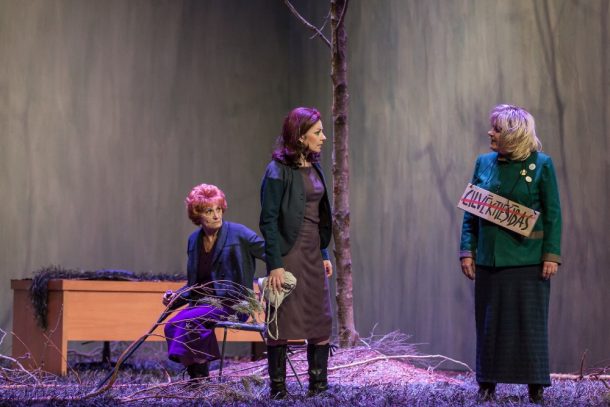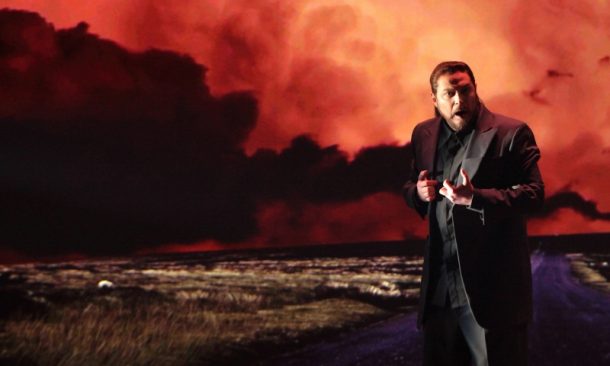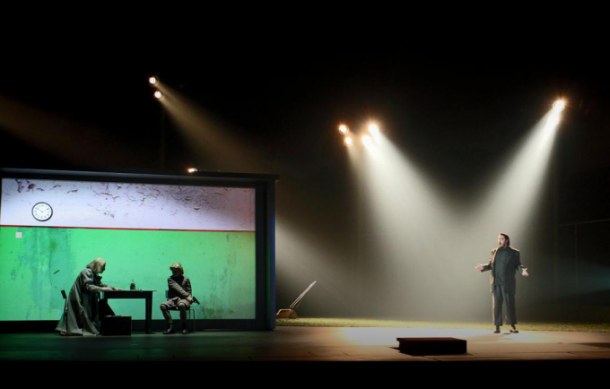Viesturs Meikšāns (b. 1980) is one of the most interesting phenomena in Latvian theatre. He cannot be called an emerging director anymore, since his first decade in this profession is coming to an end; however, he has such an interesting and intense self-driven educational program that he has retained the spirit of a discoverer. He belongs to a generation that started to develop an interest in the theatre after Latvia had gained its independence. The world was open, both for traveling and for gathering information. Having obtained a solid education in finance and worked a high-paying job at an international audit company, he realized that his life was mundane and took steps to change it, beginning by studying directing at the Latvian Academy of Culture. Perhaps it is this very background, structured by exact figures and definite solutions, that drives him to ask questions that do not have one correct answer. After graduating from the Academy, he staged several plays to try out the possibilities of psychological theatre only to abandon it, never to return. He shifted his focus to the exploration of mythology and ritual. Starting with classical works or film scripts, he broke them down to pieces and then, using them as building blocks, constructed something entirely new. Sometimes, it worked out brilliantly. A few times he failed miserably. A couple of years ago he came to Shakespeare, staging Richard III (2014) as a means of approaching the topic of modern-day politicians. He later continued this approach in the opera with Verdi’s Macbeth (2016), still with his gaze turned on politicians.
The insect under the magnifying glass
The rules of the game Meikšāns set in his Richard III (Daile Theatre, Rīga) are clear from the beginning. Time: modern day, setting: near us. Richard III, as he is portrayed by Artūrs Skrastiņš from the very beginning, is a politician, not a soldier, and the “winter of discontent” has been, say, a heavy pre-election campaign, an inter-faction conflict, or the forming of a government; there is nothing of a bloody battle between royal families. It is also obvious that the mentioned deaths are more likely to refer to political, not physical, corpses. Politics is the real time and space of the production.
The scenographer Reinis Suhanovs (a regular member of Meikšāns’ team, who was trained in directing as well as scenography) has divided the very large, and quite inconvenient for actors, stage into several segments and made a distinction between foreground and background. Each new twist reveals another corner of big politics. At times, the action takes place, seemingly, on two levels of perception: we see some things directly and others through the view and enlargement of a video camera. One of the design settings is a façade with a wide glass door, and the wall becomes a screen for those on the outside, i.e., the spectators. It is fascinating to simultaneously see the political “actors” in their natural size and intensity, and watch the images of their public “television reality”: the way a fairly calm person turns into a sickeningly aggressive monster at maximum close-up.
Almost the entire first act demonstrates this duality of politicians’ behavior—the relatively honest (because to what extent can we say we know how truthful it is) side, and the side intended for the public. But this duality reaches a whole new level—much like in a computer game—and intensity of effect, when the politician par excellence, Richard, Duke of Gloucester, gets to it.
On the same façade-turned-screen, Skrastiņš as Richard delivers the first monologue, defining himself as a hunchback. I find it to be a very important moment: this Duke of Gloucester is neither crippled nor ugly—a normal young person, charismatic enough for a politician with clear speech and a complete lack of illusion. At this moment, he is alone and therefore probably not lying—so he thinks that his own deformity is moral instead of physical. He generally has an understanding of good and evil, and he is aware that he has chosen the latter. He has the criteria. It is here in front of the house that he charms Lady Anne (Ilze Ķuzule-Skrastiņa) so thoroughly that the mourning widow has to be reminded of the forgotten urn containing her late husband’s ashes. What is it that this Richard uses to mesmerize the widow of the man he himself has finished off? Serenity and logic, or—what is even more essential for a politician—an apparent but undeniable, even in an agitated state, delivery of causal accusation: you have yourself to blame!

Shakespeare’s Richard III. Photo: Gunārs Janaitis.
Another masterstroke of Richard’s is fashioned by the creators of the production: he is behind the glass door of the façade, and the public can see him on the screen, beginning an official speech composed by a speechwriter, then suddenly “realizing” he is not saying the right words, exiting, speaking directly to the public and now really saying only what his “heart tells him” to. (The heart tells him to speak, if I’m not mistaken, an American politician’s speech.) And, having thus “disowned” political lies, he has convinced his grateful listeners of his truthfulness and gained their trust, in order to safely continue sinking into much deeper lies.
The “openness” of Richard III will backfire on him severely; the ghosts that haunt Richard are not the souls of murdered enemies but the promises he once uttered. Words yelled in the political game resonate from all directions, and it is impossible either to fire them or to cry them off.
The calm, imperturbably cold and clever Richard is, just like his colleagues, a political workhorse drawn to a level of absolute abstraction, who can solve any task, problem or conflict, because it is simply a task, problem or conflict. They do not see people in these equations.
Meikšāns’ concept (put the political manipulator under a magnifying glass like an insect and show what he looks like both at his natural size and under political magnification) is very interesting and powerful. Unfortunately, it comes to an end without ever reaching any significant generalization. Maybe we can call it by its old-fashioned name: morals. Meikšāns has deprived Richard III of his famous monologue in which his conscience is devouring him. This Richard passes from this life never having recognized the true scope of his malice. These days, we are accustomed to seeing Shakespeare subjected to every possible de- and re-construction. However, from the standpoint of modern-day society, I still feel sorry that Meikšāns refused the opportunity to remind us that this worldly life is finite for everyone—even politicians—and that, in the end, one cannot avoid looking their good and bad deeds in the eye; that remorse and retribution will come, for this is the way of the world throughout the ages.
Voices from the underworld
Macbeth is Meikšāns’ second production at the Latvian National Opera. Several years ago, he staged the opera Mikhail and Mikhail Play Chess by the composer Kristaps Pētersons, which is a story about the historical match of two world champions Mikhail Tal and Mikhail Botvinnik—artistry against bare intellect. However, it was a newly created contemporary opera, the world premiere of which was developed through cooperation between a composer, two conductors (the chess pieces of each color had their own!), a director and a scenographer. Since the structure of contemporary opera, in which music as a means of expression interacts with the other stage effects, is essentially different from that of classical opera, it is not possible just to “listen” to it. It needs to be listened to and watched—comprehended.
Different principles altogether underlie Giuseppe Verdi’s Macbeth. Music is the true backbone of the work. In the twenty-first century, opera houses have been taken over by a wave of directors coming from the dramatic theatre, and they have boldly changed many of the internal rules that had persisted for 300 years before. However, one principle has stayed intact: the opera is a syncretic work of art, its central axis being musical dramaturgy. Meikšāns, once again together with scenographer Suhanovs, had to take these rules into consideration. They accepted the challenge. Director and scenographer, in cooperation with choreographer Linda Mīļā, began by creating the environment, the context of the production within which singers, chorus, and dancers would perform. Observing the specifics of vocal mastery, the choreographic score is left mainly to the extras, thus allowing soloists to sing almost without motion; however, this lack of movement is not graceless “parking and barking,” but, instead, a principle. Each of the protagonists’ essential arias acts as a “still frame” of sorts, a moment stopped in time, in which the protagonist is either working out a dialogue with themselves or expressing their “credo.”

Giuseppe Verdi’s Macbeth, directed by Viesturs Meikšāns. Photo: Agnese Zeltina.
The time and place is altered from medieval Scotland to a world in the twentieth or twenty-first century. It is a simultaneously beautiful and dangerous world for a human, constantly subjected to ceaseless storms and elements, a reality indicated by the grotesque, seemingly wind-blown wigs worn by the characters. There are almost no stage sets. Video projections create all, thus allowing the environment to constantly change: an alarming night forest can turn into an enormous stadium created not for athletic games, but for demagogues to mesmerize and subdue the thousands and millions gathered there; a menacing sky before a storm transforms into a desert-like industrial landscape with high voltage transmission towers.
The principle of a magnifying glass used in Richard III is transformed here into a peculiar portal to a parallel world. A small screen with multiple functions is situated on one side of the stage. At the beginning of the show, it “zooms in” on a fragment of a battlefield occasionally crossed by explosions or shooting missiles. Distant human shapes appear, approach the screen, and step out of it—they are Macbeth and Banquo, who have trotted along the battlefield displayed on the screen. They come from another dimension somewhere behind the “forest” we can see. At another time, the screen becomes, for example, a roadside motel where mercenaries are lying in wait for Banquo and his son.
Macbeth, as he appears in Meikšāns’ interpretation, starts as a mid-level politician, perhaps a United Nations mission official. He is truly familiar with war, but commences to commit terrifying acts, having imagined himself as a new messiah with the knowledge of a higher truth. His actions are those of one held captive b his inner visions. Witches’ prophecies echo from the underworld, or, possibly, the protagonist’s subconscious. The chorus sings from the orchestra pit without being seen by the public, and Banquo cannot hear it. Macbeth’s visions seize Lady Macbeth as well, and she supports him with the uneasy zeal of a suburban “first lady”.
It might seem that Meikšāns wants to expose the protagonists as ruthlessly as he does in Richard III. Moreover, they are not even glib politicians like Richard III; they are entangled in their own ideas and visions. However, Verdi, following Shakespeare’s example, has granted them the exact thing Meikšāns denied Richard. Embedded in the music is the “awakening” of the protagonists and their comprehension of their own wrongdoing. And Meikšāns follows the music.

Verdi’s Macbeth. Photo: Agnese Zeltina.
One of the most touching moments of the show is Lady Macbeth’s sleepwalking scene. She wanders not the passages of her castle, but the streets of a small town. This time, the screen displays a remote gas station. Ghostly creatures slip out of the dark—six dancers slide around Lady Macbeth in synchronous movement, rising and falling, disappearing whenever she wants to touch them only to reappear behind her back. They are strange creatures—not entirely alive, because the living cannot have such mechanical movements; not entirely dead, either, because the dead can no longer feel pain, whereas the existence of these creatures is dictated by pain. These grotesque and menacing figures, much like the Witches, are not visible to anyone else—neither the Doctor nor the Gentlewoman, who sympathizes with Lady Macbeth. It is a direct reference to the victims of another one of Shakespeare’s villains, Richard III, whom he sees in his nightmares. Meikšāns is not afraid to deliver the lesson he himself declined to include in his production of Richard III. Viesturs Meikšāns has created a performance that is a parable of politics created by mediocrities imagining themselves to be the chosen ones. However, in following the dramaturgy of the music, he has not denied Shakespeare’s villains the right to reach enlightenment, even if it is to come in the face of death. The result is a production in which Shakespearean passion meets Verdian emotion and the reality of modern-day politics.
Edīte Tišheizere, Dr.art. is a Latvian theatre critic and researcher, Editor-in-Chief of Latvian theatre quarterly Teātra Vēstnesis (Theatre Herold), researcher of Institute of Literature, Folklore and Arts of the University of Latvia. Studied in Lunacharsky State Theatre Institute (Moscow). Major publications: Abpus rāmjiem (Out of Frames: Latvian directors on art and directing); Režijas virzieni un personības Liepājas teātrī (Directing in Liepaja theatre: Trends and Personalities). In English: “Text and Context: The Productions of Tennessee Williams’s A Streetcar Named Desire Through Changing times”; “Text in Contemporary Theatre: The Baltics within the World Experience; Liepaja theatre”; “Latvian Theatre from Beginnings to Nowadays”; Latvia, history and historical fantasy in the creative works of Banuta Rubess; LATVIA AND LATVIANS: A People and a State in Ideas, Images and Symbols; “The Latvian Theatre Poster: Reality Overcome.”
European Stages, vol. 7, no. 1 (Fall 2016, Special Issue: Shakespeare in Europe, 2016)
Editorial Board:
Marvin Carlson, Senior Editor, Founder
Krystyna Illakowicz, Co-Editor
Dominika Laster, Co-Editor
Kalina Stefanova, Co-Editor
Editorial Staff:
Cory Tamler, Managing Editor
Mayurakshi Sen, Editorial Assistant
Advisory Board:
Joshua Abrams
Christopher Balme
Maria Delgado
Allen Kuharsky
Bryce Lease
Jennifer Parker-Starbuck
Magda Romańska
Laurence Senelick
Daniele Vianello
Phyllis Zatlin
Table of Contents:
- Some Quadricentennial Shakespeare in Germany by Marvin Carlson
- Tiago Rodrigues’s Antony and Cleopatra by Manuel García Martínez
- Amleto: An Opera Rediscovered by Katrin Hilbe
- Coping With the Greatest for Over One Hundred Years by Alen Biskupović
- The Art of Sharing Shakespeare: Emil Boroghină, a Romanian Sorcerer by Maria Zărnescu
- Shakespeare’s Villains and Modern Politicians in Latvia by Edīte Tišheizere
- A Queen for a King! Tom Lanoye’s Königin Lear at Schauspiel Frankfurt by Katrin Hilbe
- The Tempest: Magical Ballet Where East Meets West by Sepideh Shokri Poori
- “The Ukrainian Play”: Macbeth Ritualized by Vlad Troitskyi by Daria Moskvitina
- Les Kurbas’s Tradition in Ukrainian Shakespeare Productions by Nataliya Torkut
Martin E. Segal Theatre Center:
Frank Hentschker, Executive Director
Marvin Carlson, Director of Publications
Rebecca Sheahan, Managing Director
©2016 by Martin E. Segal Theatre Center
The Graduate Center CUNY Graduate Center
365 Fifth Avenue
New York NY 10016



